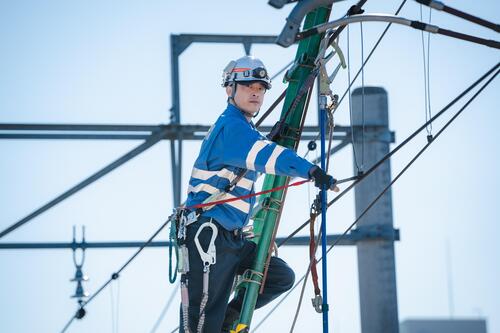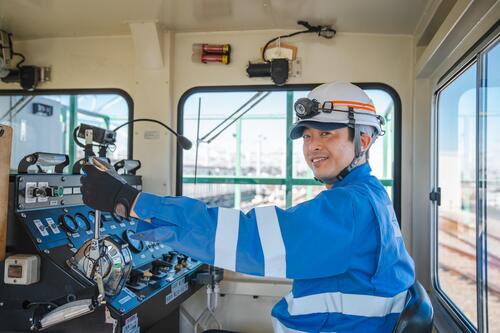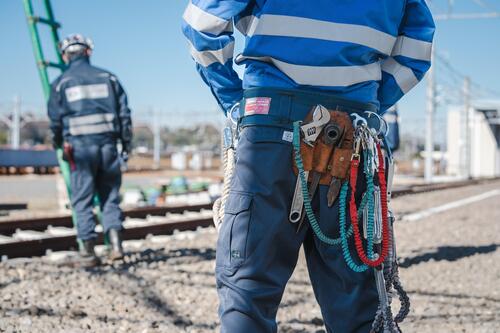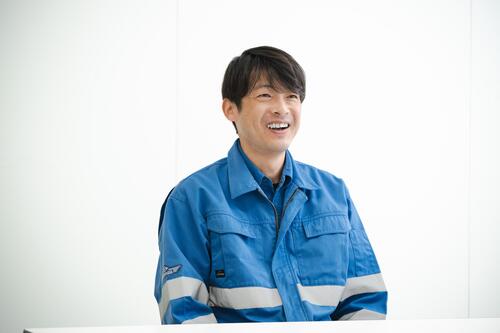Here's the text.
STORY (Spring 2024 issue)
Last Updated April 3, 2024
The City of Yokohama, Transportation Bureau public relations magazine "Gurutto" introduces people who work on municipal subways and buses under the title "Works STATION."
This series focuses on the backside of municipal transportation, which is hard to know in daily life. We will deliver interviews that did not fit in the magazine as a web-only article! This time, this is an interview with Takuya Arai, an electric ward employee who is in charge of maintenance and management of electrical equipment at the Kawawa Maintenance Management Office.

The nerves of the Yokohama Municipal Subway
"What do you find rewarding in this job?" 。 Arai answered this question:
"What makes me rewarding is that trains move normally without delay in time. That's proof of safety, and there's no equipment failure. I'm glad I did it today as well."
Mr. Arai is engaged in maintenance and inspection of substations on municipal subways and electrical equipment at stations. Lighting and disaster prevention equipment in the station yard, as well as overhead lines where pantographs at the top of the train touch. It is said that everything we usually see casually is managed by staff like Arai.
Electricity sent from a power company is converted at a substations and delivered to each station or train. It is thanks to the work of the electric ward staff that the train moves and the station welcomes customers. City of Yokohama, Transportation Bureau's recruitment information page also states that electric ward officials are "manipulating the nerves of the subway."
The schedule for a day is quite hard. It is basically a day shift that starts at 8:30 am and leaves the office at 5:15 pm, but sometimes goes to night work and construction work. The work of entering the track or touching the overhead line that is powered during the train operation starts after the last train. The work lasts until the first train, and after a nap or takeover, the work ends at 8:30 am Of course, this kind of lodging work is rotated, but it will never be an easy task.

Arai rides on the track motor car used in track work after the last train. Since it moves only back and forth, sit sideways so that both can be easily seen.
First of all, safety first
Arai's previous job was a hairdresser. I liked moving my hands and doing fine work. I have been playing with plastic models of vehicles since I was a child, and I still like DIY who assemble and paint furniture by myself. It was ten years ago that Mr. Arai joined City of Yokohama, Transportation Bureau.
"After working in a beauty salon in Tokyo or Kanagawa, I was thinking about my future career. So I found City of Yokohama, Transportation Bureau's recruitment information. At first, I was puzzled by a different industry. But I'm from the electronic machinery department at a technical high school and like to maintain something. I chose my current job because I wanted to be able to support people from the bottom."
Immediately after joining the station, he did not have the necessary qualifications, so he acquired qualifications such as electricians and firefighters. Dangerous work with electricity up to 66,000 volts. "Anyway, safety first," he said.
"If you touch things, try to touch them with proof that electricity is never flowing." Inspections must be carried out according to the inspection procedure manual. Also, protective equipment is also important. I always wear boots and gloves. And it is also essential to talk to each other. "I'm away from this way." I will teach you not to act alone."
"I don't think customers can see this kind of work.……", Arai smiled modestly. However, he said, "It's important to be normal and not to miss small abnormalities that are different from usual so that customers can safely ride the train."

A belt with lifelines and work tools hanging around. It seems to be about 2 kilograms, and when I bring it, it is heavy and heavy.
Day and night for our customers
Mr. Arai supports such "invisible places", but he often has opportunities to interact with customers.
"When I check the station premises, I ask you about the road and the location of nearby commercial facilities, so I try to understand the geography around the station. I will try to respond politely without ending with "I don't know because I'm not a station clerk."

Mr. Arai during the interview
The number of vehicles on the Green Line running at Kawawacho Station, the nearest Kawawa Maintenance Office, is increasing to six vehicles. In addition, the Blue Line, which runs alongside the Green Line at Centerminami Center-Kita Station, has been switched to a new 4000 series vehicle. In his daily work, he realizes that vehicle equipment is getting up to date and comfortable.
"It's difficult for technical staff like me to send a message to customers, but I'd like to tell you that I'm working every day so that I can operate safely both day and night, so I'd like to tell you that you should ride with confidence. When I was a child, I was playing with plastic models of cars and motorcycles, and I liked vehicles. That's why I'm glad I could do this for my job."
Arai used to work in a different field as a hairdresser. However, considering that I liked vehicles since I was a child, I liked to move my hands, and that I attended the electronic machinery department at a technical high school, I said, "I feel like I have returned to my original state."
Above all, "safety" and "normal" are important. Mr. Arai is a powerful person under the edge.
Inquiries to this page
Transportation Bureau General Affairs Department General Affairs Division
Telephone: 045-671-3147
Telephone: 045-671-3147
Fax: 045-322-3911
Email address: kt-koho@city.yokohama.jp
Page ID: 719-863-671

